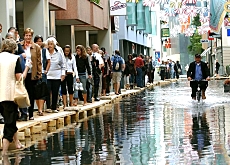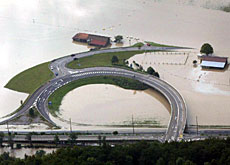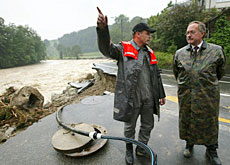Skies clearing but the alert is far from over

Evacuation and containment operations continued in the areas worst affected by this week's flooding, while sunshine brought some respite to rescue services.
The government extended its sympathy to the families of the flooding victims. It thanked all those involved in the rescue and clean-up efforts but did not specify how much financial aid would be allocated.
Although the weather forecast is favourable for the coming days, the alert is far from over in many areas, particularly in Lucerne and Bern.
Four people have been killed in the flooding and another three are still missing. The government said it was shocked at the extent of the weather catastrophe.
Government spokesman Oswald Sigg said the government would do everything in its power to support the affected cantons and communities.
Sigg said the commitment of the police, the fire service, civil protection service, the army and countless volunteers was exemplary and deserved the highest recognition.
Widespread disruption
In Lucerne, large parts of the city are under water and traffic is cut off on either side of the river Reuss. The situation has deteriorated at the Perlen dam, raising fears of water breaking through.
The lakes of Thun and Brienz have stabilised at very high levels and they are not expected to subside for several days. Driftwood has washed into the lakes and is piling up at weirs and causing concern, particularly at Thun.
In Bern, the River Aare remains at very high levels in the Matte neighbourhood. Fearing the collapse of certain buildings, the city authorities ordered the complete evacuation by air of the remaining Matte residents on Wednesday.
Villages such as Wilderswil, Brienz, Oey and Reichenbach in the Bernese Oberland region are scenes of devastation in the wake of mudslides and racing torrents of water. The authorities are working to restore transport links and electricity.
Counting the cost
Tourists and residents stranded in Engelberg and Melchtal may have to wait for special escape routes to be constructed to reconnect them to the rest of the country. They received supplies by helicopter on Wednesday and some tourists were airlifted out.
Rail services are gradually returning to normal but many roads remain impassable, mainly in central Switzerland. The Gothard tunnel rail and road connections are still closed.
Bern University historian Christian Pfister estimates that the severe weather may have caused damage of up to SFr2 billion ($1.6 billion). He compared the current events with the flooding of the summer of 1987, which caused damage worth SFr1.3 billion.
The worst of the wet weather appears to be over. Weather forecasters say that conditions will remain calm until the middle of next week with little rain.
swissinfo with agencies
After three days of flooding, water levels in most areas have stabilised although some dams and weirs are under pressure from blocked driftwood.
Weather forecasters say that conditions will remain calm until the middle of next weak with little rain.
Bern historian Christian Pfister, author of comparative studies on natural disasters in Switzerland, estimates that the damage caused by the ongoing floods could cost up to SFr2 billion ($1.6 billion).
The worst flooding of the 20th century took place in 1987 with total damage worth SFr1.7 billion.

In compliance with the JTI standards
More: SWI swissinfo.ch certified by the Journalism Trust Initiative


You can find an overview of ongoing debates with our journalists here. Please join us!
If you want to start a conversation about a topic raised in this article or want to report factual errors, email us at english@swissinfo.ch.